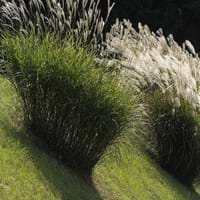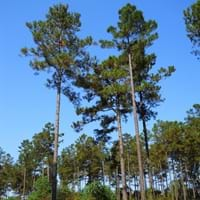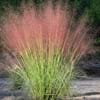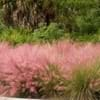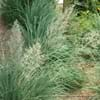Life Span
Perennial
Perennial
Origin
Hybrid origin
Southeastern United States
Types
Not Avaialble
it is a variety of pine
Habitat
Lake Sides, savannahs
Fields
USDA Hardiness Zone
5-9
6-9
Sunset Zone
1a, 1b, 2a, 3a, 3b, 4, 5, 6, 7, 8, 9, 10, 11, 12, 13, 14, 15, 16, 17, 18, 19, 20, 21, 22, 23, 24
H1
Habit
Clump-Forming
Upright/Erect
Flower Color
Not Available
Not Available
Flower Color Modifier
Bicolor
Bicolor
Fruit Color
Not Available
Brown
Leaf Color in Spring
Green
Green
Leaf Color in Summer
Light Green
Green
Leaf Color in Fall
Green, Purple, Burgundy, Bronze
Green
Leaf Color in Winter
Not Available
Green
Leaf Shape
Grass like
Needle like
Plant Season
Summer, Fall
Spring, Summer, Fall, Winter
Sunlight
Full Sun, Partial Sun
Full Sun, Partial Sun
Growth Rate
Slow
Very Fast
Type of Soil
Clay, Loam, Sand
Clay, Loam, Sand
The pH of Soil
Acidic, Neutral
Acidic, Neutral
Soil Drainage
Average
Well drained
Bloom Time
Early Summer, Summer, Late Summer, Early Fall
Not Available
Tolerances
Drought
Drought
Where to Plant?
Ground
Ground
How to Plant?
Rhizome division
Seedlings, Transplanting
Plant Maintenance
Medium
Medium
Watering Requirements
Average Water Needs, Do Not over Water
Do not let dry out between waterings, Requires a lot of watering
In Summer
Lots of watering
Lots of watering
In Spring
Moderate
Ample Water
In Winter
Average Water
Lots of watering
Soil pH
Acidic, Neutral
Acidic, Neutral
Soil Type
Clay, Loam, Sand
Clay, Loam, Sand
Soil Drainage Capacity
Average
Well drained
Sun Exposure
Full Sun, Partial Sun
Full Sun, Partial Sun
Pruning
Remove damaged leaves, Remove dead branches, Remove dead leaves
Prune to stimulate growth
Fertilizers
All-Purpose Liquid Fertilizer
All-Purpose Liquid Fertilizer, Apply 10-10-10 amount, High-phosphorous fertilizers used, organic fertlizers
Pests and Diseases
No serious insect or disease problems
Bark beetles, Beetles, Black root rot, Root rot
Plant Tolerance
Drought
Drought
Flower Petal Number
Single
Not Available
Fragrant Bark/Stem
No
Yes
Foliage Texture
Coarse
Fine
Foliage Sheen
Glossy
Matte
Allergy
Not Available
Asthma, Skin rash
Aesthetic Uses
bank hedging, Mixed Border, Showy Purposes
Showy Purposes
Beauty Benefits
Not Available
Not Available
Environmental Uses
Air purification
Air purification
Medicinal Uses
No Medicinal Use
No Medicinal Use
Part of Plant Used
Whole plant
Stem
Other Uses
Screen, Used as Biofuel, Used for making hedge
used for making roof trusses, poles, joists, piles, Wood is used for making furniture
Used As Indoor Plant
No
No
Used As Outdoor Plant
Yes
Yes
Garden Design
Hedges, Mixed Border, Screening / Wind Break
Shade Trees, Street Trees
Botanical Name
MISCANTHUS Giganteus
PINUS taeda
Common Name
Giant Silvergrass
Loblolly Pine
In Hindi
Giant Silvergrass
loblolly pine
In German
Riesenschilf
Weihrauchkiefer
In French
géant silvergrass
pin à encens
In Spanish
Giant Silvergrass
pino taeda
In Greek
Giant Silvergrass
loblolly πεύκο
In Portuguese
Silvergrass gigante
Pinus taeda
In Polish
Giant Silvergrass
Loblolly sosna
In Latin
Giant Silvergrass
pinea taeda
Phylum
Magnoliophyta
Coniferophyta
Class
Lilopsida
Pinopsida
Clade
Angiosperms, Commelinids, Monocots
Not Available
Tribe
Andropogoneae
Not Available
Subfamily
Panicoideae
Not Available
Number of Species
Not Available
Not Available
Properties of Giant Silvergrass and Loblolly Pine
Wondering what are the properties of Giant Silvergrass and Loblolly Pine? We provide you with everything About Giant Silvergrass and Loblolly Pine. Giant Silvergrass doesn't have thorns and Loblolly Pine doesn't have thorns. Also Giant Silvergrass does not have fragrant flowers. Giant Silvergrass has allergic reactions like Not Available and Loblolly Pine has allergic reactions like Not Available. Compare all the properties and characteristics of these two plants. Find out which of these plant can be used as indoor plant. If you are interested to decorate your house and garden, find out aesthetic uses, compare them and select the plant which will beautify your surrounding. Along with beautification, try comparing medicinal and edible uses of Giant Silvergrass and Loblolly Pine and you can choose the plant having best and most benefits.
Season and Care of Giant Silvergrass and Loblolly Pine
Season and care of Giant Silvergrass and Loblolly Pine is important to know. While considering everything about Giant Silvergrass and Loblolly Pine Care, growing season is an essential factor. Giant Silvergrass season is Summer and Fall and Loblolly Pine season is Summer and Fall. The type of soil for Giant Silvergrass is Clay, Loam, Sand and for Loblolly Pine is Clay, Loam, Sand while the PH of soil for Giant Silvergrass is Acidic, Neutral and for Loblolly Pine is Acidic, Neutral.
Giant Silvergrass and Loblolly Pine Physical Information
Giant Silvergrass and Loblolly Pine physical information is very important for comparison. Giant Silvergrass height is 240.00 cm and width 120.00 cm whereas Loblolly Pine height is 1,830.00 cm and width 610.00 cm. The color specification of Giant Silvergrass and Loblolly Pine are as follows:
Giant Silvergrass flower color: Not Available
Giant Silvergrass leaf color: Green
Loblolly Pine flower color: Not Available
- Loblolly Pine leaf color: Green
Care of Giant Silvergrass and Loblolly Pine
Care of Giant Silvergrass and Loblolly Pine include pruning, fertilizers, watering etc. Giant Silvergrass pruning is done Remove damaged leaves, Remove dead branches and Remove dead leaves and Loblolly Pine pruning is done Prune to stimulate growth. In summer Giant Silvergrass needs Lots of watering and in winter, it needs Average Water. Whereas, in summer Loblolly Pine needs Lots of watering and in winter, it needs Lots of watering.
